Note: typo on page 5 – the final concert of the year will be in April 2014 not April 2013.
@@@@@@@@@@@@@@

The Mishras – Pandit Shivnath Mishra & Deobrat Mishra (Sitars), Prashnat Mishra (Tabla), Sunday May 12, 2013, 7:30pm at Centre 64.
It seems that to be an Indian Classical Musician one needs to be born into the family “business”. It also helps if one is dedicated to many, many hours of hard practice. The great Indian Sarod player Ali Akbar Khan belonged to a family dynasty of musicians and started his formal studies as a vocalist at the age of 3. His lessons with his farther extend over the entire length of each day. The sitar player Ravi Shankar and his daughter Anoushka are another well known inter-generational family of Indian classical musicians. To this list we can add The Mishras who were in Kimberley for a concert at Centre 64. With 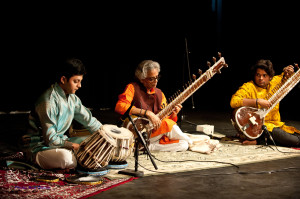 the grandfather Pandit Shivnath Mishra, the son Deobrat Mishra and the nephew Prashant Mishra it was a rare opportunity to hear an inter-generational family of Indian musicians sharing their music with the world. This is their second visit to Kimberley. Deobrat and Prashant performed at Centre 64 back in 2010. (for the review and images from that concert go to the link The Mishras ). At that time the Tabla player Prashant was still in his teens. For this concert the two younger musicians were joined by the grandfather Shivnath on one of his rare trips outside his native home in Benares, India. For this particular performance they performed the raga GWATI as the first half of their program. Normally an Indian raga can go for several hours but as a concession to western audiences they are usually shortened. That being said this raga lasted around 60 minutes. That is somewhat longer than your average 3 minute pop tune. As with their previous concert the second half of the program was dedicated to shorter pieces that included a composition dedicated to Holi, the Indian Festival of Colors, a composition dedicated to Shiva and another in keeping with our wonderful mountain scenery. The Mishras intend to resume their teaching agenda in Nelson in the near future and should be back through this region next year. Here are some more images from the concert (click for a larger view).
the grandfather Pandit Shivnath Mishra, the son Deobrat Mishra and the nephew Prashant Mishra it was a rare opportunity to hear an inter-generational family of Indian musicians sharing their music with the world. This is their second visit to Kimberley. Deobrat and Prashant performed at Centre 64 back in 2010. (for the review and images from that concert go to the link The Mishras ). At that time the Tabla player Prashant was still in his teens. For this concert the two younger musicians were joined by the grandfather Shivnath on one of his rare trips outside his native home in Benares, India. For this particular performance they performed the raga GWATI as the first half of their program. Normally an Indian raga can go for several hours but as a concession to western audiences they are usually shortened. That being said this raga lasted around 60 minutes. That is somewhat longer than your average 3 minute pop tune. As with their previous concert the second half of the program was dedicated to shorter pieces that included a composition dedicated to Holi, the Indian Festival of Colors, a composition dedicated to Shiva and another in keeping with our wonderful mountain scenery. The Mishras intend to resume their teaching agenda in Nelson in the near future and should be back through this region next year. Here are some more images from the concert (click for a larger view).
@@@@@@@@@@@@@@@@@@@
Recently Tom Bungay and Gene Anderson (The East-West Connection) were invited to 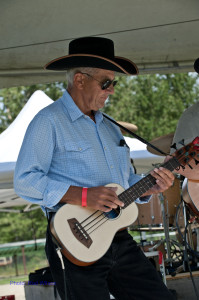 perform at a recent outdoor event in the Kimberley Platzl. While they were kicking back and taking in the sights Gene, who is a bass player, noted that he could hear a bass but couldn’t see one in the group performing. He was right. There were bass lines riding in the band without a bass in sight. Larry Tuck of Tuck’s Troubadours, for a number of reasons, had forsaken his bass guitar for a Bass Ukulele. He is the first, and only musician that I know of in this area, who has gone down that route. I suspect he will not be the last to take on this light weight alternative to the bass guitar. Below is a review of the Karla U-Bass by Greg Olwell. I have lifted this from the most recent edition of Acoustic Guitar.
perform at a recent outdoor event in the Kimberley Platzl. While they were kicking back and taking in the sights Gene, who is a bass player, noted that he could hear a bass but couldn’t see one in the group performing. He was right. There were bass lines riding in the band without a bass in sight. Larry Tuck of Tuck’s Troubadours, for a number of reasons, had forsaken his bass guitar for a Bass Ukulele. He is the first, and only musician that I know of in this area, who has gone down that route. I suspect he will not be the last to take on this light weight alternative to the bass guitar. Below is a review of the Karla U-Bass by Greg Olwell. I have lifted this from the most recent edition of Acoustic Guitar.
“Sometimes you show up for a picking session and you’re out of luck. There are already too many guitarists and you don’t want to add another six-string to the party, but hey look, nobody’s playing bass! Or, maybe your home recordings need some low end and you want an easy-to-play bass with a big sound. If this sounds familiar, the U-Bass from the ukulele specialists at Kala Brand may be just what you need. With its small size, the U-Bass is easy to carry and play, and when played through an amp, produces a big bass sound.
With its small body, ultrashort 21-inch scale (compared to a typical Fender-style bass’s 34-inch scale), and thundering plugged-in bass sound, the U-Bass defies all sense of proportion. However, spend a little time with one and you may quickly find that the U-Bass moves past “brain-warping novelty bass” to become an inviting instrument that could be a very useful and inspiring tool. Kala has an extensive line of U-Basses, with different woods and body shapes (traditional, cutaways, and solid bodies), as well as fretless versions. We checked out the entry-level U-Bass-SMHG – Mahogany, Baritone-Uke Size Body
Though Kala never refers to this instrument as a “ukulele bass,” coming from a company that is one of the biggest players riding the current wave of ukulele mania, it’s hard to think of this instrument any other way. Roughly the size of a baritone ukulele, the U-Bass has a slightly longer neck (a 21-inch scale versus a baritone uke’s 19-inch scale), and the mahogany neck, with 12 frets to the body, is stout, feeling much more like a full-size bass guitar neck than that of a ukulele.
The U-Bass’s body is built with a solid flamed mahogany top and solid mahogany back and sides. The top and back are bound with tortoiseshell-color plastic and the sound hole is ringed by a simple white rosette. The frets were nicely dressed, never causing a buzz and free of sharp edges. One of the U-Bass’s unusual features is the small hatch on the back, directly behind the bridge area, which allows the instrument’s unique rubber strings to be fed through the top and bridge.
To amplify the U-Bass, Kala chose Shadow electronics, consisting of a Nanoflex under saddle pickup and small preamp mounted on the bass’s side, with a chromatic tuner and controls for volume and tone. The preamp is powered by a pair of CR2032 button batteries, which are loaded through a small sliding compartment near the standard end pin jack.
Unique Strings: The heart of the U-Bass’s one-of-a-kind feel and sound is its strings. Thick and stretchy like gummy worms, the U-Bass’s polyurethane strings have a smooth, slick texture and are a nice evolution from the sticky silicone strings used on the U-Bass’s ancestor, the Ashbory Bass, a minuscule bass sold by Guild and later DeArmond. The strings’ elasticity, low tension, and super thick gauges are key to the bass’s gloriously thuddy sound, but the very same qualities that yield a convincing upright bass sound also require frequent tuning. They’re just so stretchy and roly-poly under your fingers that changes in temperature or humidity, or enthusiastic playing, can knock them out of tune faster than you might be accustomed to with steel strings. So, I appreciated the high-quality Hipshot Ultralite tuning machines, on board tuner, and Graph Tech nut for making tuning easy. Though the U-Bass comes with a Graph Tech nut, which should help the strings slide smoothly across the nut during tuning, I took the additional step of equalizing the tension on either side of the nut by gently lifting the strings slightly above the nut. I found this helped cut down on intonation changes during playing.Thanks to its size, guitarists might have an easy time adapting to this small bass. The spacing is tighter than a typical guitar, but it feels friendly and was easy to get used to. The neck shape felt familiar, too, and made playing for extended periods comfortable.
Little Bass, Big Boom: With its tiny body and big, flappy strings, the U-Bass has an acoustic volume that’s fine for plucking at home, but it probably won’t be loud enough to compete with most other acoustic instruments. You’ll need an amp for that and when you plug in, you’ll find that the bass’s real strength is its plugged-in sound. At low volumes, you’re probably fine playing through a standard acoustic amp, though higher levels would benefit from a dedicated bass amp. I played the U-Bass through Fender Bassman TV and SWR Baby Blue bass amps at a few rehearsals with my jazz big band and experienced a bit of cognitive dissonance: the plugged-in sound from this laughably small bass was as authoritative as James Earl Jones’s voice. When I switched from amplified upright bass to the U-Bass during our louder, more rocking songs, the sound from the little bass was nothing short of thunderous. Even plugged into my amp’s active input, which attenuates some input signal, the Shadow pickup’s output was tremendous, requiring me to lower my amp’s volume from the upright’s setting. The U-Bass had some of the most delicious, no-nonsense fundamental bass tone imaginable. Even with the onboard electronics’ tone control turned up to its most treble-heavy setting, the tone was pure, thick fundamental, nearly free of all the upper-end information acoustic guitarists crave for a sparkly sound. Instead of creating a lacy, high-end sound, turning the tone control up gave the U-Bass a little more click on the notes’ attack, which helped provide more right-hand detail. But, for my ears, I preferred the onboard tone control down in its lower half, which trims the high-end, much like a tone control does on an electric guitar, leaving a thick, supportive sound. For a bass player, this meat-and-potatoes sound is the foundation you’ll need for most of your bass lines. I also never had a problem with feedback; even when I tried to induce it, the little guy wouldn’t cooperate.
Take It Along: For anyone who needs an acoustic bass, or simply wants to explore the beauty of some low-end sounds, the Kala U-Bass should be high on your list of basses to demo. You won’t need to be in a ukulele band to pull it off either—several top-shelf bassists, like Bakithi Kumalo, Leland Sklar, and Abe Laboriel, have discovered the charm of the U-Bass and use it regularly onstage in a variety of venues. Far beyond novelty, the U-Bass is a real-deal bass, built well to deliver serious thunder. The best part? Its tiny size makes it perfect to carry along with your acoustic guitar gear, in case the jam calls for something besides another guitar.
SPECS: Four-string miniature acoustic bass. Solid mahogany top, back, and sides. Mahogany neck. Rosewood fingerboard and bridge. Graph Tech nut. 21-inch scale. 1 13/16-inch nut width. Matte finish. Hipshot Ultralite tuners. Pahoehoe polyurethane strings. Shadow Nanoflex bridge pickup with SH NFX EQ-T onboard active electronics. Made in China.
PRICE: $660 list/$550 street.
MAKER: Kala Brand Music: (877) 853-3853; kalabrand.com.”
Although in the review the price is listed as $550-$660 a quick search on the internet yielded prices that were significantly under $400. That sounds like a hell of a deal for anyone interested in experimenting with the instrument.
Check the YouTube video in the on-line review Karla U-Bass
@@@@@@@@@@@@@@@@@@
2013/05/21 – this just in – Mike and Anie Hepher at the CLAWHAMMER GALLERY are now an official Kala dealer so they can get that bass uke and any other uke gear in. They stock about 6-10 ukes at any given time. as well as accessories like straps and strings and tuners. Thanks for the info Mike.
@@@@@@@@@@@@@@@@@@
Locals Coffee House May 4, 2013 7:30 pm at the Studio / Stage Door in Cranbrook.
Every musician, regardless of genre, needs to get to grips with the music of Bach. On a similar, but not as an intense a note, every tune-smith or purveyor of traditional music should pay some attention to the music of Stephen Foster. His tunes have been around for over 150 years so they must have some merit. In fact his songs and tunes are a goldmine 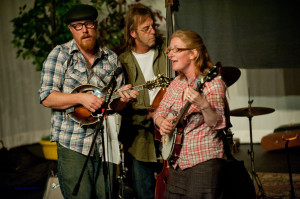 of material for re-interpretation and performance. Case in point. At the LOCALS Coffee House on Saturday night, late in the program, RedGirl (Mike and Anie Hepher with Steve Jones) took to the stage and kicked off their set with Stephen Foster’s Angeline the Baker. From the moment that Mike’s delicate muted mandolin intro sounded they had me. For me this was a complete re-invention of a tune that we have been kicking around for years. But Mike’s vocal and mandolin, Anie’s clawhammer banjo and Steve’s bass playing took the song to a whole new level. As a band RedGirl has been around for a number of years and like all great musicians they continue to evolve. The new format (at least to my ears) of the band is a more stripped down acoustic version of their former self. On this particular night the emphasis on mandolin, clawhammer banjo and ukulele was a pure delight. I hope they are planning a recording session in the near future. But I am getting
of material for re-interpretation and performance. Case in point. At the LOCALS Coffee House on Saturday night, late in the program, RedGirl (Mike and Anie Hepher with Steve Jones) took to the stage and kicked off their set with Stephen Foster’s Angeline the Baker. From the moment that Mike’s delicate muted mandolin intro sounded they had me. For me this was a complete re-invention of a tune that we have been kicking around for years. But Mike’s vocal and mandolin, Anie’s clawhammer banjo and Steve’s bass playing took the song to a whole new level. As a band RedGirl has been around for a number of years and like all great musicians they continue to evolve. The new format (at least to my ears) of the band is a more stripped down acoustic version of their former self. On this particular night the emphasis on mandolin, clawhammer banjo and ukulele was a pure delight. I hope they are planning a recording session in the near future. But I am getting 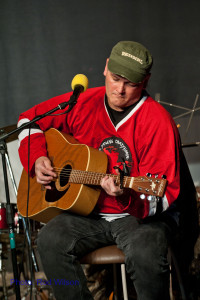 ahead of myself. They were in fact the last act in an evening of incredible music. A couple of new musical duos kicked off the night. First out of the gate was JR LIVES with Jon Bisset on guitar and vocals and Rod Wilson on Irish Bouzouki. Their selections included Carrot Juice is Murder and Neil Young’s Old Man. A couple of months back Dave Prinn (guitar and vocals) hooked up with Bill Renwick (guitar, harmonica and vocals) at an
ahead of myself. They were in fact the last act in an evening of incredible music. A couple of new musical duos kicked off the night. First out of the gate was JR LIVES with Jon Bisset on guitar and vocals and Rod Wilson on Irish Bouzouki. Their selections included Carrot Juice is Murder and Neil Young’s Old Man. A couple of months back Dave Prinn (guitar and vocals) hooked up with Bill Renwick (guitar, harmonica and vocals) at an 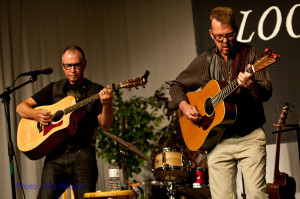 open-mic session at BJ’s Creekside Pub in Kimberley. The musical chemistry was immediate. They have cemented their musical relationship into the duo VESTED INTERESTS and I guess this was their first formal performance. Both musicians are strong guitarists and vocalists and they seem to seamlessly slip into complementary roles. With his strong performances in many sessions over the past few years Dave is the better known musician. Bill may be the lesser known but I suspect that will change. His voice is a wonderfully polished version of Neil Young, that is if Neil could actually sing. (don’t get me wrong, I like Neil Young). They kicked off their set with an Eagles tune (I missed the name), followed by a Dave Prinn original called Gonna Ride That Big Twin Home (a motor cycle trip from California to Edmonton) and Bill Renwick’s Hold Me in Your Arms Tonight. They rode out on a blaze of glory on James Taylor’s Steam Roller Blues. Tom Bungay is also a
open-mic session at BJ’s Creekside Pub in Kimberley. The musical chemistry was immediate. They have cemented their musical relationship into the duo VESTED INTERESTS and I guess this was their first formal performance. Both musicians are strong guitarists and vocalists and they seem to seamlessly slip into complementary roles. With his strong performances in many sessions over the past few years Dave is the better known musician. Bill may be the lesser known but I suspect that will change. His voice is a wonderfully polished version of Neil Young, that is if Neil could actually sing. (don’t get me wrong, I like Neil Young). They kicked off their set with an Eagles tune (I missed the name), followed by a Dave Prinn original called Gonna Ride That Big Twin Home (a motor cycle trip from California to Edmonton) and Bill Renwick’s Hold Me in Your Arms Tonight. They rode out on a blaze of glory on James Taylor’s Steam Roller Blues. Tom Bungay is also a 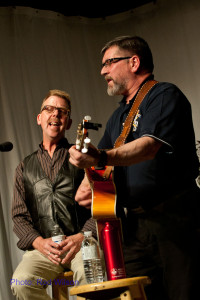 regular on the session scene and for this night’s performance he decided to take it down a notch with a couple of tribute performances dedicated to Rita MacNeil and George Jones. Dave Prinn stepped on
regular on the session scene and for this night’s performance he decided to take it down a notch with a couple of tribute performances dedicated to Rita MacNeil and George Jones. Dave Prinn stepped on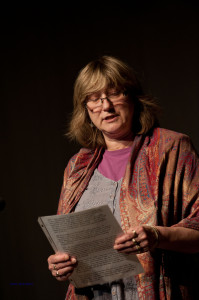 stage to sing harmony behind Tom on Rita’s Working Man. The song He Stopped Loving Her Today was the George Jones tribute. Tom’s wife Verna joined him for their masterpiece monologue / song Wave Over Wave – a very fitting tribute to the sailors of Newfoundland. Also featured was the song Jeckyl and Heyde. This is a fine piece of song writing by Tom’s eighteen year old daughter.The Quimby’s (Erin and Ferdy
stage to sing harmony behind Tom on Rita’s Working Man. The song He Stopped Loving Her Today was the George Jones tribute. Tom’s wife Verna joined him for their masterpiece monologue / song Wave Over Wave – a very fitting tribute to the sailors of Newfoundland. Also featured was the song Jeckyl and Heyde. This is a fine piece of song writing by Tom’s eighteen year old daughter.The Quimby’s (Erin and Ferdy 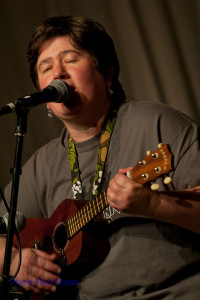 Belland) with some able help from Mike and Anie Hepher strutted out some covers of Blue Rodeo and the John Prine song called In Spite of Ourselves. This song could be, so they say, the story of their married life. Erin, like Annie (and a whole horde of other musicians) has become a devotee of the Ukulele. It is an instrument that has come out of the shadows and has become an important ingredient in “Jaiwaiin” music (ie. a mixture of island music from Jamaica and Hawaii). I am not sure under what banner James and Tristan Neve, Rob Young and Ferdy Belland are travelling but I guess Lonesome Jim is a good
Belland) with some able help from Mike and Anie Hepher strutted out some covers of Blue Rodeo and the John Prine song called In Spite of Ourselves. This song could be, so they say, the story of their married life. Erin, like Annie (and a whole horde of other musicians) has become a devotee of the Ukulele. It is an instrument that has come out of the shadows and has become an important ingredient in “Jaiwaiin” music (ie. a mixture of island music from Jamaica and Hawaii). I am not sure under what banner James and Tristan Neve, Rob Young and Ferdy Belland are travelling but I guess Lonesome Jim is a good 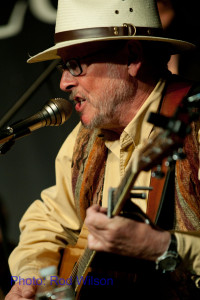 as any. As always Jame’s original songs continue to astound and on this night the band included Hold On, Passing Through Your Heart, and Take the Wheel. Also, as always, Rob Young contributed some fine lead guitar work, including some of his rarely heard slide
as any. As always Jame’s original songs continue to astound and on this night the band included Hold On, Passing Through Your Heart, and Take the Wheel. Also, as always, Rob Young contributed some fine lead guitar work, including some of his rarely heard slide 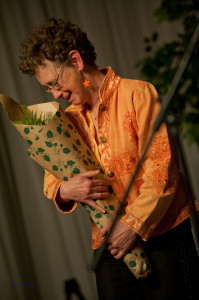 playing.
playing.
This Saturday night was the end of LOCALS 2012/2013 winter season and it was also a special night to pay tribute to Beth Crawley who was stepping down after chairing the LOCALS Committee for 15 years. Thanks Beth for all your hard work over the past years. Beth proved time and time again that by presenting local artists the quality of musicians in the area is second to none and that the Studio / Stage is a venue that captures the real essence of music – music that is unique, personal, and intimate. It is music that is shared among local musicians and their friends and deserves to be shared by the wider community.
Here are some more images from an unforgettable evening of music:
Home Grown Coffee House May 4, 2013 7:30 pm at Centre 64 in Kimberley.
Unfortunately I haven’t yet found a way to be in two places at the same time so I had to make a choice. Which Coffee House should I attend? LOCALS or HOME GROWN ? LOCALS was closer to home and I was performing there in a duo with Jon Bisset (JR Lives) so that decided the issue. Still it would have been nice to attend both.
@@@@@@@@@@@@@@@
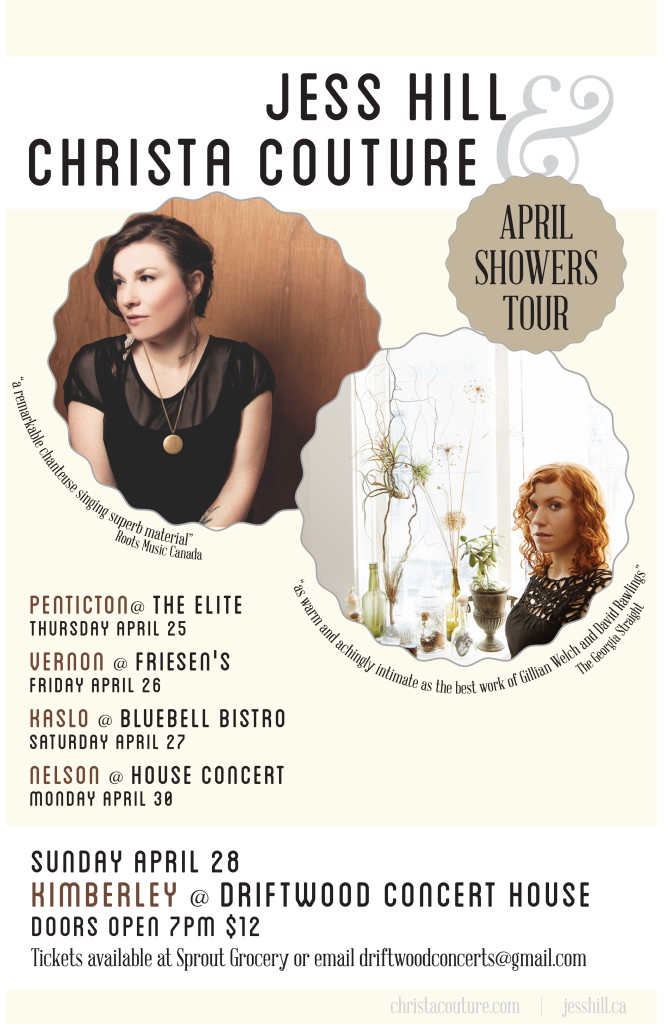 For the Kimberley stop off in this mini-tour the weather co-operated fully. It was a gorgeous spring weekend with the April showers descending on the Driftwood Concert House just as the concert began. For this last concert of the Driftwood Concert House Spring Series Christa Couture and Jess Hill, both ladies from Vancouver, treated the audience to a fine selection of original material. Of the two performers Jess Hill (guitar and vocals) who opened the evening, was closer to the folky singer /song writing tradition of the likes of Joni Mitchell. The songs, tunes, words and delivery may have been different but this was familiar territory. During her performance she, in part, explored her fascination
For the Kimberley stop off in this mini-tour the weather co-operated fully. It was a gorgeous spring weekend with the April showers descending on the Driftwood Concert House just as the concert began. For this last concert of the Driftwood Concert House Spring Series Christa Couture and Jess Hill, both ladies from Vancouver, treated the audience to a fine selection of original material. Of the two performers Jess Hill (guitar and vocals) who opened the evening, was closer to the folky singer /song writing tradition of the likes of Joni Mitchell. The songs, tunes, words and delivery may have been different but this was familiar territory. During her performance she, in part, explored her fascination 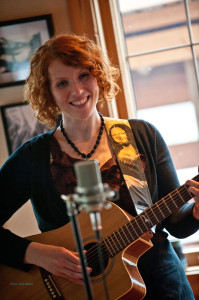 with moths. One of the songs, An Open Letter to My Heart, she used the insect’s behavior as a metaphor for her love life. The imagery revolved around a moth’s navigational skills being dominated by the light of the moon in much the same way as in human emotions “Love still lights the way”. In both instances a miscalculation can lead to getting lost or even burnt. Another song, with a slight blues inflection, was the result of a lay over in Paris on a long trip back from Africa. This is her mother’s favorite and it is easy to see why. A couple of the nice lines in the song included ” I’ve got to be sure my shadow keeps up with me” and “a shadow makes good company”. In the audience participation number the chorus of the song “My, oh My Baby” got an immediate response without too much coaxing. The lines “fox in the meadow and the wolf in the woods” and “It’s no surprise the stars have eyes” were also nice images. A nice feature of her guitar accompaniments was her delicate finger picking.
with moths. One of the songs, An Open Letter to My Heart, she used the insect’s behavior as a metaphor for her love life. The imagery revolved around a moth’s navigational skills being dominated by the light of the moon in much the same way as in human emotions “Love still lights the way”. In both instances a miscalculation can lead to getting lost or even burnt. Another song, with a slight blues inflection, was the result of a lay over in Paris on a long trip back from Africa. This is her mother’s favorite and it is easy to see why. A couple of the nice lines in the song included ” I’ve got to be sure my shadow keeps up with me” and “a shadow makes good company”. In the audience participation number the chorus of the song “My, oh My Baby” got an immediate response without too much coaxing. The lines “fox in the meadow and the wolf in the woods” and “It’s no surprise the stars have eyes” were also nice images. A nice feature of her guitar accompaniments was her delicate finger picking.
The poster had Christa Couture (vocals, guitar and piano) defined as a Chanteuse. The New Penguin English Dictionary’s definition of the word is: “Chanteuse /shon’tuhz-/ noun (pl Chanteuses) a female nightclub or cabaret singer”. In the vernacular she would 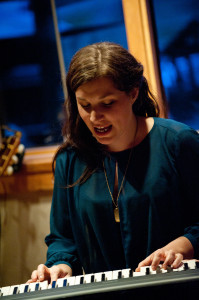 be described as a singer/song writer. However, the word Chanteuse with its urbane nuance, is probably a more accurate reflection of her material and delivery. Songs included You Know I Don’t Play Piano, Parasite, and The Boy Down the Bayou. In the very near future Christa will be off on a tour of the EU and the UK. Almost as we speak her latest CD The Living Record is being released (April 29th, 2013) in the UK. Here are some more images from The Driftwood Concert House and the evenings performance.
be described as a singer/song writer. However, the word Chanteuse with its urbane nuance, is probably a more accurate reflection of her material and delivery. Songs included You Know I Don’t Play Piano, Parasite, and The Boy Down the Bayou. In the very near future Christa will be off on a tour of the EU and the UK. Almost as we speak her latest CD The Living Record is being released (April 29th, 2013) in the UK. Here are some more images from The Driftwood Concert House and the evenings performance.
@@@@@@@@@@@@@@@@